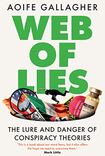
In recent years, the world has had a crash course in the vile, sometimes violent outcomes that occur when conspiracy theories meet the internet. As conspiracy researcher Aoife Gallagher shows in her new book, Web of Lies: The Lure and Danger of Conspiracy Theories, many of today’s theories, trailing centuries-long histories, quickly found a welcoming home on the internet, starting with its early chatrooms and discussion boards.
But the lightning-fast discussion and distribution medium of the current big social media platforms, such as Facebook, Twitter, TikTok, Instagram and YouTube, have facilitated the spread of disinformation more efficiently and effectively than ever before. Their algorithms are designed to elevate widely-shared content, so if someone clicks on just one conspiracy-related post or video, more are likely to pop up to draw the unsuspecting further down the conspiracy rabbit hole. Web users uninterested in conspiracy content can remain blissfully unaware of these cesspools.
The Covid-19 pandemic helped expose this strange world, one that had already been expanding with orchestrated intent from the time of the 2016 US presidential election. Conspiracies benefit from societal tension, doubt and confusion, and as the pandemic took hold, social media timelines were flooded with conspiracy click-bait. But it’s still easy to overlook the proliferation, reach and radicalising danger of these online conspiracy subcultures, even as their ugly theories have inched into public discourse, mainstreamed by celebrities, conservative media and politicians and, of course, a chaotic US president.
Gallagher notes that an Economist and YouGov poll at the end of the 2016 election year found that nearly half of Trump voters — 46 per cent — believed there was at least some truth in the utterly loony Pizzagate conspiracy that emerged from wacky interpretations of the hacked emails of Hillary Clinton’s campaign manager John Podesta, widely pushed by right-wing media and conspiracy websites such as Alex Jones’s notorious InfoWars.
‘Forget about glamour’: Jonathan Anderson offers advice to would-be fashion designers as he receives TCD honour
Death of Pope Francis: Derek Mooney leads RTÉ’s coverage to intermittently jaw-dropping effect
Chob Thai restaurant, Clontarf: The most memorable thing here is the bill
Careless People: The controversial book is shocking and reveals Facebook is far worse than we could have suspected
This freakish variation on the age-old “they’re coming for our children” conspiracy trope ludicrously placed senior Democrats, including Clinton, at the centre of a human trafficking and child sex ring supposedly run from a popular family pizza restaurant in Washington DC.
Crazy, for sure, but that didn’t prevent an armed true believer from showing up at the busy pizzeria and firing a weapon. At least no one was hurt. But many innocent people have died at the hands of people — mostly young white men — obsessed with these conspiracy falsehoods.
The Irish angle could productively have been the book’s primary focus, supported by the global (mostly US) background — wandering equally between the two at times feels disjointed
Web of Lies is an informative book for anyone who wants to better understand conspiracy theories and why some people fall for them. It is particularly interesting in exploring how a handful of conspiracies with long histories have spawned worrying, interlinked web-driven variations in the 21st century. As Gallagher notes: “Movements and ideologies that were not linked previously were now coming together in a new hybridised force.”
She also traces some surprising Irish historical connections to conspiracies and examines current Irish iterations and their links to global conspiracy networks, an important warning that Ireland has not evaded such extremism.
The Irish angle could productively have been the book’s primary focus, supported by the global (mostly US) background — wandering equally between the two at times feels disjointed. Others have written in-depth on online conspiracy theories, but the Irish aspect is fresh and intriguing and deserving of more source material (more source attribution generally would have been helpful, too). With such a complex topic, the omission of an index is unfortunate.
A complimentary take on the web’s dark side is provided by Chris Gray in The Moderator: Inside Facebook’s Dirty Work in Ireland, covering his experiences as a content moderator (officially, a “community operations analyst”) for Facebook in Dublin. In that role, Gray dealt with a wide range of horrific material, some of it the output of the conspiracy mongers. He argues that hours of exposure to a miserable spectrum of dire human behaviour, including the unspeakable horrors of self-harm, suicide, killings and child abuse, led to his diagnosis of post-traumatic stress disorder.
In 2019, Gray gained international recognition as a whistleblower, exposing the ghastly realities of this poorly-paid, external-contractor job. As he makes clear, the personal price for moderators is severe, and Facebook placed a low priority on this stressful, important job and a low value on the tens of thousands of people doing it, kept at benefits-free arm’s length as third-party contractors.
One feels compassion for Gray and his struggles in this hideous job with this alienating company, and there’s much of interest here. But a firmer editorial hand would have helped lift and focus this often rambling, overly detailed narrative, which suffers from reading more as a personal justification for a lawsuit he’s brought against Facebook (a point stressed repeatedly) than a broader exposé.















